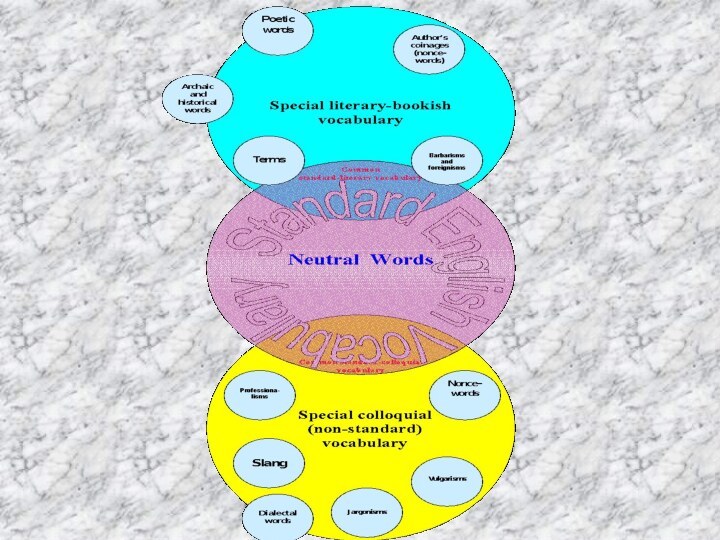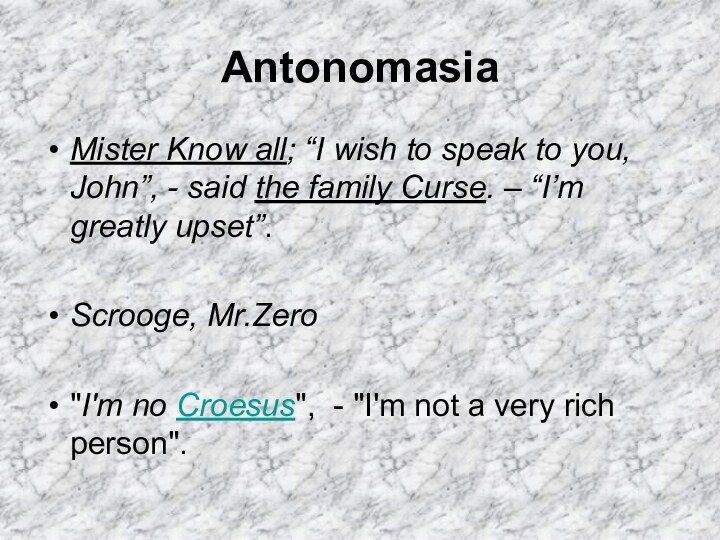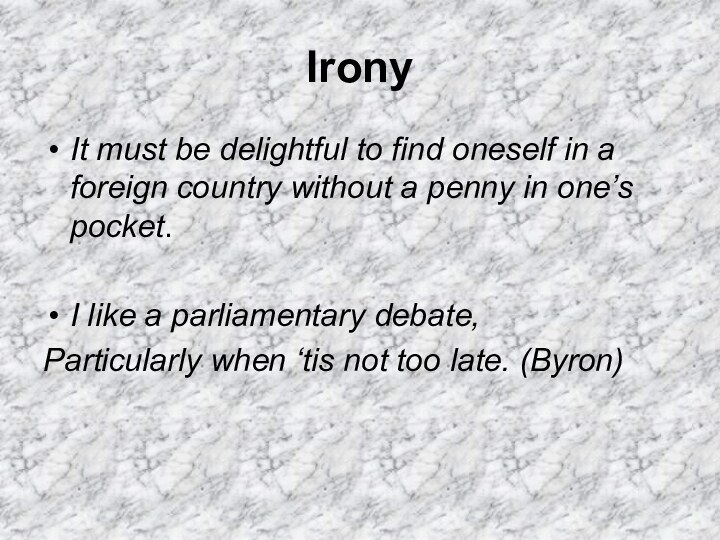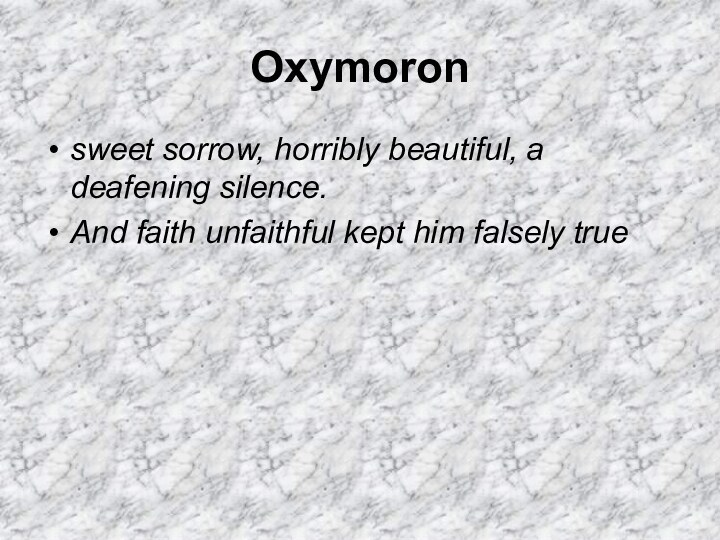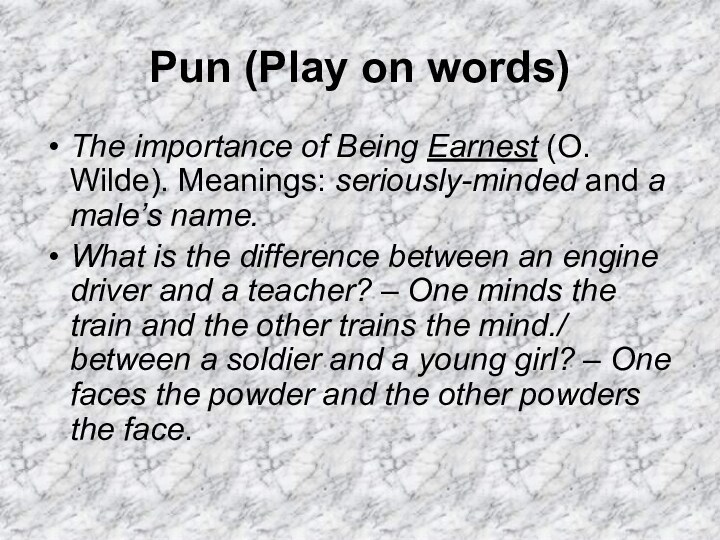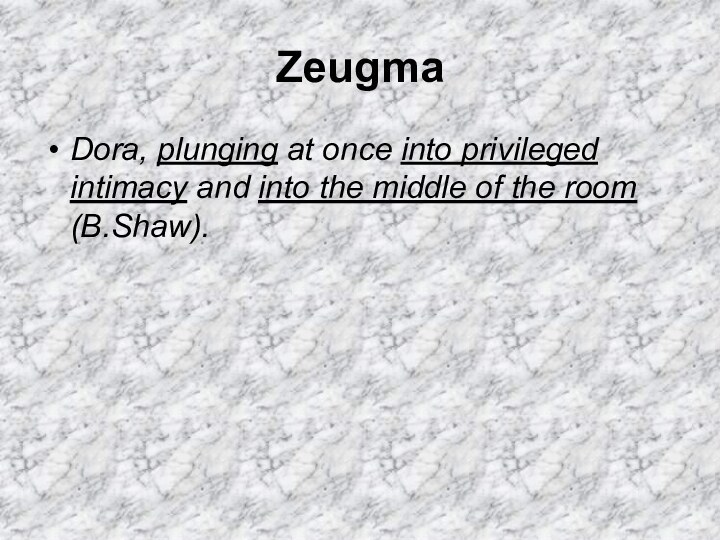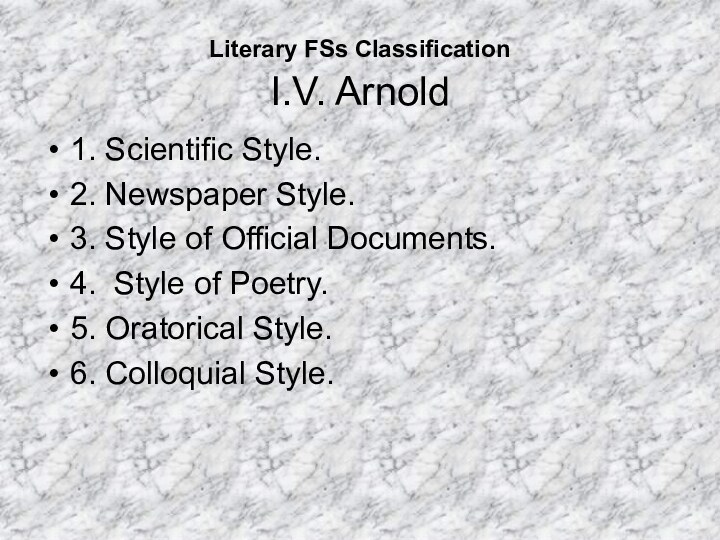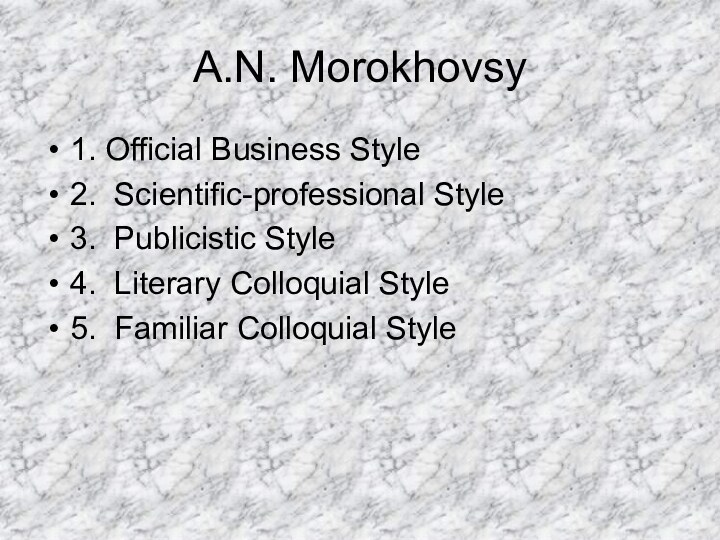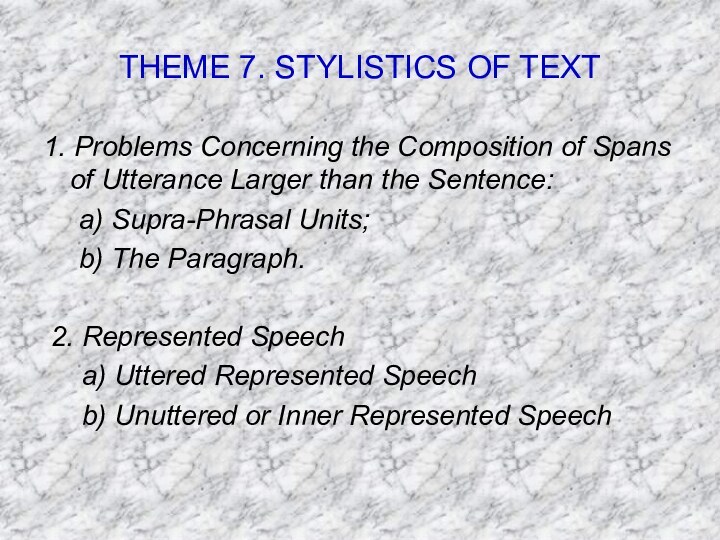Слайд 2
The Object of Stylistics
The object of stylistics is
language because stylistics is a branch of linguistics.
Stylistic is
a branch of linguistics, the subject of which is the study of language styles (their aims, structure, characteristic features the effect they produce).
The norm should be regarded as the invariant of the phonemic, morphological, lexical and syntactical patterns circulating in language-in-action at a given period of time.
Слайд 3
Stylistic Means
All stylistic means can be divided into:
expressive and stylistic devices.
The expressive means of a language
are those phonetic, morphological, word-building, lexical, phraseological and syntactical forms which exist in language-as-a-system: for the purpose of logical and/or emotional intensification of the utterance. Expressive means exist on every level of language.
Stylistic device is a conscious and intentional intensification of some typical structural and/or semantic property of a language unit promoted to a generalized status and thus becoming a generative model.
Слайд 4
A Functional Style
A functional style of a language
is a system of interrelated language means which serves
a definite aim in communication. In the English literary standard we distinguish the following major functional styles:
The language of belles-lettres.
The language of publicistic literature.
The language of newspapers.
The language of scientific prose.
The language of official documents.
Colloquial style.
Слайд 5
Meaning
In stylistics meaning is viewed as a category
which is able to acquire meanings imposed on the
words by context.
Types of meaning
Denotational, which informs of the subject of communication.
Connotational, which informs about the participants and conditions of communication.
Connotational meaning includes evaluative, emotive, expressive and stylistic components.
Слайд 7
Theme 2
Phonetic Expressive Means and Stylistic Devices. Stylistic
Morphology.
Plan
Sound instrumenting.
Rhyme, rhythm.
Stylistic morphology:
morphemic repetition;
extension of morphemic valency.
Слайд 8
Onomatopoeia
There are two variations of onomatopoeia: direct
and indirect.
Direct (explicit)
roar, mew, oink-oink, ding-dong;
Mr. Bingley,
while shaving on the day after his fiftieth birthday saw his reflection & admitted his remarkable resemblance to a mouse: “Cheep-cheep!” he said to himself with a shrug.
Indirect onomatopoeia
“Whenever the moon and stars are set,
Whenever the wind is high…” (R.S. Stevenson).
And the silken, sad, uncertain rustling of each purple curtain" (E. A. Poe)
Слайд 9
Alliteration (Consonance)
The possessive instinct never stands still
(J. Galsworthy)
Deep into the darkness peering, long I
stood there wondering, fearing, doubting, dreaming dreams no mortals ever dared to dream before (E. A. Poe).
Слайд 10
Assonance
…Tell this soul with sorrow laden, if
within the distant Aiden,
I shall clasp a sainted maiden,
whom the angels name Lenore –
Clasp a rare and radiant maiden, whom the angels name Lenore?
"some ship in distress that cannot live."
Слайд 11
Euphony
She is like a beautiful exotic flower
that must be sheltered from bitter winds.
Isabel is infinitely
good for me. I admire her more than any woman I’ve ever known. She has a wonderful brain & she is as good as she is beautiful. I respect her energy & her ambition. She was born to make success in life. I’m entirely unworthy of her.
Слайд 12
Paronomasia
raven, never
the raven, never flitting, still is
sitting, still is sitting
Слайд 13
Rhythm
“…there passed the thought confused and difficulty grasped
that he had only heard her use it,…” (S.
Maugham. The Painted Veil).
/ ─│/ ─│/ ─│/ ─│//│/ ─│//│/ ─│/ ─│/ ─│/,
Слайд 14
Types of rhyme
complete/exact/full/identical rhymes (might-right) and incomplete/slant/half/ approximate/imperfect/near/oblique.
cat, cot; hope, cup; defeated, impeded.
2) single (masculine)
– double (feminine) - apocopated - triple.
cope, hopeless; kind, finder
3) simple (eye-rhyme)-compound (mosaic).
"upon her honour - won her", "bottom –forgot them- shot him“
According to the way the rhymes are arranged within a stanza, certain models have crystallized:
1. couplets – the last words of two successive lines are rhymed – aa;
2. triple rhymes – aaa;
3. cross rhymes – abab;
4. framing/ring rhymes – abba.
Слайд 15
Graphon
This intentional violation of the graphical shape of
a word (or word combination) used to reflect its
authentic pronunciation is called graphon
Graphon proved to be an effective means of supplying information about the speaker's origin, social and educational background, physical or emotional condition.
Слайд 16
Morpheme
The basic unit of the morphological level being
a morpheme we shall concentrate on examining the ways
of foregrounding a morpheme so that the latter, apart from its internet meaning, becomes vehicle of additional information - logical, emotive, expressive.
One important way of promoting a morpheme is its repetition.
The second, even more effective way of using a morpheme for the creation of additional information is extension of its normative valency which results in the formation of new words.
Слайд 17
Theme 3
Stylistic classification of the English Vocabulary
Plan
General Considerations.
Neutral,
Common Literary and Common Colloquial Vocabulary.
Special Literary Vocabulary.
Special Colloquial
Vocabulary
Слайд 18
The word-stock of the English language may be
divided into three main layers (strata):
the literary layer
(stratum),
the neutral layer
the colloquial layer.
The aspect of the literary layer is its bookish character, which makes the layer more or less stable.
The aspect of the colloquial layer is its lively spoken character, which makes it unstable, fleeting.
The aspect of the neutral layer is its universal character. It can be employed in all styles of language and in all spheres of human activity. This makes the layer the most stable of all.
Слайд 19
The literary vocabulary
common literary;
terms and learned [′
lə:nid] words;
poetic words;
archaic words;
barbarisms and foreign words;
literary coinages
and nonce-words.
Слайд 20
The colloquial vocabulary
common colloquial words;
slang;
jargonisms;
professionalisms;
dialectal words;
vulgar words;
colloquial coinages
The common literary, neutral and common colloquial
words are grouped under the term Standard English Vocabulary.
Слайд 23
Theme 4
Semasiological Expressive Means and Stylistic Devices of
the English Language
Plan
Semasiological Expressive Means of the English Language.
Semasiological
Stylistic Devices of the English Language.
Слайд 24
Semasiology (from Gr . semasia - "signification") deals
not with every kind of linguistic meaning only.
The
subject of stylistic semasiology is not the basic meaning of a linguistic unit as such but its additional meaning which appears in two cases:
1) in case of unusual denotative reference of words, word-combinations, utterances, texts;
2) in case of unusual distribution of the meaning expressed by these units
In stylistic semasiology we distinguish EM and SD.
Слайд 26
HYPERBOLE
The girls were dressed to kill.
I loved Ophelia;
forty thousands brothers
Could not, with all their quantity of
love
Make up my sum.
(W. Shakespeare. Hamlet)
Слайд 27
Meiosis
It cost me a pretty penny, I can
tell you.
Слайд 28
Litotes
The decision was not unreasonable.
The venture was
not impossible.
Слайд 29
Metonymy
…then they came in. two of them, a
man with long fair moustache and a silent dark
man…Definitely, the moustache and I had nothing in common (Doris Lessing).
the roses are blooming in her heart.
Слайд 30
Synecdoche
Caroline lives with Jack under the same
roof (under the same roof in the same house).
The hall applauded (the hall = the people inside).
Слайд 31
Periphrasis (circumlocution)
weapons = instruments of destruction; love
the most pardonable of human weaknesses
to marry = to
tie the knot (metaphor)
cotton = white gold; furs = soft gold.
Слайд 32
Euphemism
negro → colored → black → African-American
→ People of Color
Слайд 33
Metaphor
he fell through a trapdoor of depression
Genuine:
Dear Nature is the kindest Mother still (Byron).
Trite
(dead): a ray of hope, floods of tears
Sustained: Mr. Dombey’s cup of satisfaction was so full at the moment… (Dickens).
Слайд 34
Antonomasia
Mister Know all; “I wish to speak
to you, John”, - said the family Curse. –
“I’m greatly upset”.
Scrooge, Mr.Zero
"I'm no Croesus", - "I'm not a very rich person".
Слайд 35
Personification
He was a small intense man like
a kettle that has just come to the boil.
His upturned nose was raised angrily, & little hot steam like bursts was coming from him. He sat down abruptly, his shoulders still rising & falling. But it was obvious that the steam pressure inside him had subsided, he had boiled himself dry in fact.
Слайд 36
Allegory
Still waters run deep
All is not gold
that glitters
Слайд 37
Epithet
I’ve a ridiculous habit of flushing when
I’m taken aback.
He was repulsive and ridiculous. She
was charming and unbearable.
The memory of a voice.
Слайд 38
Irony
It must be delightful to find oneself
in a foreign country without a penny in one’s
pocket.
I like a parliamentary debate,
Particularly when ‘tis not too late. (Byron)
Слайд 40
Simile
She was like a celebrated chewing-gum. The
taste lingered. (Wodehouse)
The wrinkled sea beneath him crawls;
He watches
from his mountain walls,
And like a thunderbolt he falls.
Слайд 41
Synonyms-substitutes
There on the table lay a number
of parcels. They were presents from his patients. Some
of them were not wrapped at all. (A. Cronin).
Слайд 42
Synonyms-specifiers
It was Bart's love and affection that
compensated for everything else. (D. Cusack).
Слайд 43
Antithesis
The room was so small & this
exhibit so large, that I had got a feeling
of wanting the air.
She was sour, but she liked sweet things.
Derrick hadn’t chosen me for my motional depth, or even for my intellectual great size.
Слайд 44
Oxymoron
sweet sorrow, horribly beautiful, a deafening silence.
And
faith unfaithful kept him falsely true
Слайд 45
Climax or gradation
it was a lovely city,
a beautiful city, a fair city, a veritable gem
of a city”. God knows I loved her. For eight years I worshipped the ground she trod on. She was intelligent & well-read. She was tender, unselfish & disinterested. In fact, she was too good to be true.
Слайд 46
Anticlimax
If John's eyes fill with tears, you
may have no doubt: he has been eating raw
onions.
Слайд 47
Pun (Play on words)
The importance of Being
Earnest (O. Wilde). Meanings: seriously-minded and a male’s name.
What is the difference between an engine driver and a teacher? – One minds the train and the other trains the mind./ between a soldier and a young girl? – One faces the powder and the other powders the face.
Слайд 48
Zeugma
Dora, plunging at once into privileged intimacy
and into the middle of the room (B.Shaw).
Слайд 49
THEME 5
SYNTACTICAL EXPRESSIVE MEANS AND STYLISTIC DEVICES
OF THE ENGLISH LANGUAGE
General Notes
2.
Syntactical Expressive Means of the English Language
3. Syntactical Stylistic Devices of the English Language
Слайд 50
Syntactical Expressive Means and Devices deal with expressive
possibilities of the structural pattern of sentences and paragraphs,
the arrangement of words in a sentence and sentences in a paragraph.
Слайд 52
EMs based on the reduction of some obligatory
elements of the sentence structure
Ellipsis
There’s somebody wants to
speak to you (Hemingway).
– Did you date her?
- This was a he. Called himself Rudi Wilson. Know him?
Слайд 53
Aposiopesis (Break-in-the-narrative)
"Well, I never!" reads approximately "Well,
I never expected it"; "I never thought of it";
"I never imagined it“
You just come home or I’ll…(threat).
Слайд 54
Nominative sentences
Gloomy Sunday (The Guardian), Atlantic Sea
Traffic (The Times), Union peace plan for Girling stewards
(Morning Star).
Слайд 55
Asyndeton
Bicket did not answer his throat felt
too dry. (Galsworthy).
"The Mole was bewitched, entranced, fascinated”
- Kenneth Grahame, The Wind in the Willows, Ch. 1
Слайд 56
EMs based on the redundancy of the elements
of the sentence
Repetition
"Words, words, words." (Shakespeare, Hamlet)
"And
the world said, disarm, disclose, or face serious consequences ... and therefore, we worked with the world, we worked to make sure that Saddam Hussein heard the message of the world." (George W. Bush)
Слайд 57
Enumeration
“…he could concentrate immediate attention on the
donkeys and tumbling bells, the priests, patios, beggars, children,
crowing cocks, sombreros, cactus-hedges, old high white villages, goats, olive-trees, greening plains, singing birds in tiny cages, water sellers, sunsets, melons, mules, great churches, pictures, and swimming gray-brown mountains of a fascinating land” (Galsworthy).
Слайд 58
Syntactical tautology
She was not a little pleasing,
this woman, he decided
And this maiden she leaved with
no other thought,
Than to love and be loved by me.
Helen Adair she loved me well
Against her father’s & mother’s will.
Слайд 59
Polysyndeton
Should you ask me, whence these stories?
Whence
these legends and traditions,
With the odours of the
forest,
With the dew, and damp of meadows,
With the curling smoke of wigwams,
With the rushing of great rivers,
With their frequent repetitions,…(H.Longfellow).
Слайд 60
Emphatic constructions
That evening it was Dave, who
read to the boys their bed-time story (D.Carter).
Слайд 61
Parenthetic sentences
“This is one of the things
I wasn't prepared for—the amount of unfilled time, the
long parentheses of nothing” (Margaret Atwood).
Слайд 62
EMs based on the violation of
the traditional word
order
Stylistic inversion
Talent Mr. M. has (Dickens);
Once upon
a midnight dreary…(Po);
A good generous prayer it was (Twain);
At your feet I fall (Dryden).
Слайд 63
Separation in syntactical units
He had never seen
the truth before, about anything. (R.Warren).
Слайд 64
Detachment
She was lovely: all of her – delightful
(T. Driser).
Слайд 66
SDs based on the formal and semantic interaction
of syntactical constructions of the models of sentences in
a certain context
Parallelism
”He knowingly lied and we blindly followed”
(A B A B)
"He knowingly lied and we followed blindly"
(A B B A)
Слайд 67
Chiasmus
A handsome man kisses misses,
An ugly
man misses kisses
She said nothing, there was nothing to
say.
I know the world, & the world knows me.
Слайд 68
Anaphora
"We shall fight on the beaches, we
shall fight on the landing grounds, we shall fight
in the fields and in the streets, we shall fight in the hills* we shall never surrender." (Winston Churchill).
Слайд 69
Epiphora
"She's safe, just like I promised. She's
all set to marry Norrington, just like she promised.
And you get to die for her, just like you promised". (Jack Sparrow, Pirates of the Caribbean).
Слайд 70
SDs based on the transposition of the meaning
of the structures in context
Rhetorical question
"How many times
do I have to tell you to stop walking into the house with mud on your shoes?“
"The whole wood seemed running now, running hard, hunting, chasing, closing in round something or--somebody? In panic, he began to run too, aimlessly, he knew not whither."
- Kenneth Grahame, The Wind in the Willows, Ch. 3
Слайд 71
SDs based on the transposition of the meaning
of connection between sentences
Parcellation
They would appear with soap.
Thin and watery. (P. White).
Слайд 72
Subordination instead of coordination, coordination instead of subordination
The Mr. X set down steering at a little
bookcase and at a window and at an empty blue bag and at a pen, and at a box of sweets.
Слайд 73
THEME 6.
FUNCTIONAL STYLES OF THE ENGLISH LANGUAGE
Functional
Styles
2. Literary FSs Classification
3.
Varieties Of Language
4. Distinctive Stylistic Features Of Functional Styles Of English
Слайд 74
The types of texts that are distinguished by
their pragmatic aspect of communication are called functional styles
of language (FS)/ discourses/registers.
A FS/discourse/register of a language is a system of interrelated language means which serves a different aim in communication.
Слайд 75
Literary FSs Classification
I.V. Arnold
1. Scientific Style.
2.
Newspaper Style.
3. Style of Official Documents.
4. Style of Poetry.
5.
Oratorical Style.
6. Colloquial Style.
Слайд 76
M.D. Kuznets and Y.M. Skrebnev
A. Literary or
Bookish Style
1. Publicistic Style
2. Scientific
(Technological) Style
3. Style of Official Documents
B. Free (Colloquial Style)
1. Literary Colloquial Style
2. Familiar Colloquial Style
Слайд 77
A.N. Morokhovsy
1. Official Business Style
2. Scientific-professional Style
3.
Publicistic Style
4. Literary Colloquial Style
5. Familiar Colloquial Style
Слайд 78
I.R. Galperin
1. Belles - Lettres Style
a) poetry;
b) emotive prose;
c) the drama
2. Publicistic Style
a) oratory and speeches;
b) essays;
c) articles in newspapers and magazines;
d) radio and TV commentary
3. Newspaper Style
a) brief news items;
b) advertisments and announcements;
c) headlines;
d) the editorial
4. Scientific Prose Style
a) exact sciences;
b) humanitarian sciences;
c) popular- science prose
5. Style of Official Documents
a) diplomatic documents;
b) business letters;
c) military documents;
d) legal documents
Слайд 79
THEME 7. STYLISTICS OF TEXT
1. Problems Concerning the
Composition of Spans of Utterance Larger than the Sentence:
a)
Supra-Phrasal Units;
b) The Paragraph.
2. Represented Speech
a) Uttered Represented Speech
b) Unuttered or Inner Represented Speech
Слайд 80
Supra-Phrasal Units
The term supra-phrasal unit (SPU) is
used to denote a larger unit than a sentence.
It generally comprises a number of sentences interdependent structurally (usually by means of pronouns, connectives, tense-forms) and semantically (one definite thought is dealt with). Such a span of utterance is also characterized by the fact that it can be extracted from the context without losing its relative semantic independence.
Слайд 81
The Paragraph
A paragraph is a graphical term
used to name a group of sentences marked off
by indentation at the beginning and a break in the line at the end. As a linguistic category the paragraph is a unit of utterance marked off by purely linguistic means: intonation, pauses of various lengths, semantic ties which can be disclosed by scrupulous analysis of the morphological aspect and meaning of the component parts.
Слайд 82
Represented Speech
The author's narrative supplies the reader
with direct information about the author's preferences and objections,
bе1ieth and сontradictions, i. e. serves the major source of shaping up the author's image.
Entrusted narrative may also be anonymous. The narrator does not openly claim responsibility for the views and evaluations but the manner of presentation, the angle of description very strongly suggest that the story is told not by the author himself but by some of his factotums—which we see, e. g., in the prose of Fl. O'Connor, С McClures, E. Hemingway, E. Caldwell.










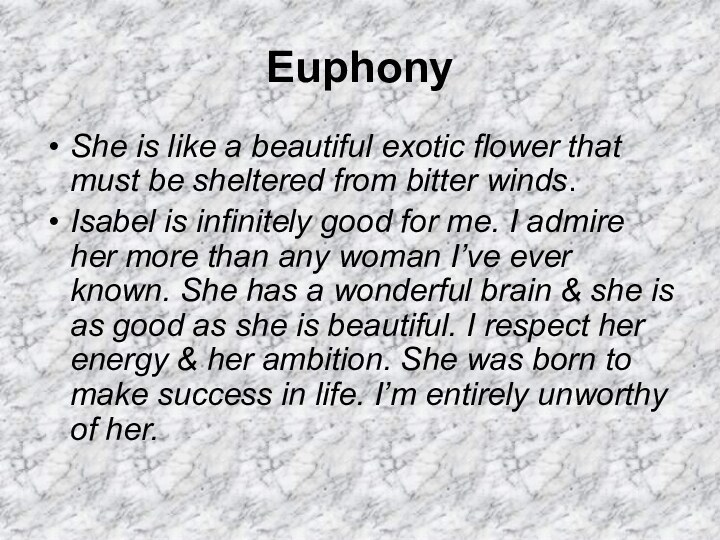

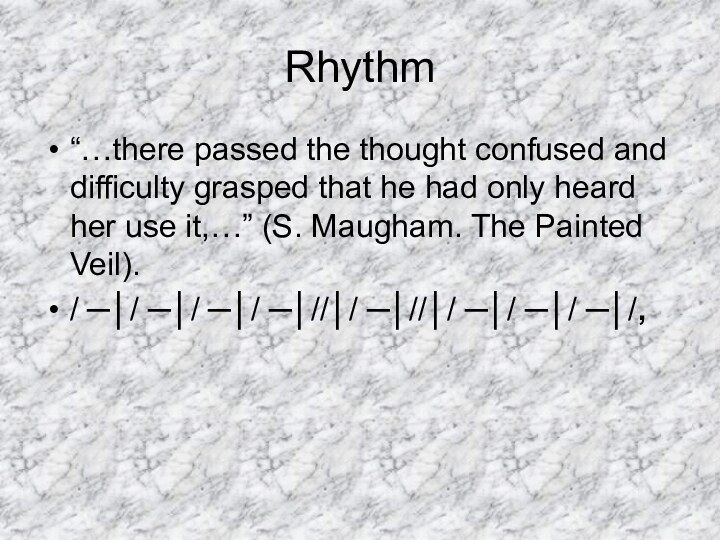





![Theme 1general notes on style and stylistics The literary vocabulary common literary;terms and learned [′ lə:nid] words;poetic words;archaic words;barbarisms](/img/tmb/13/1295834/d8f3c536b2b4861d8161531d066d30d3-720x.jpg)

